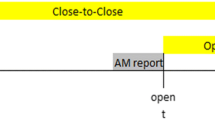Abstract
Empirical research to date on the relative effectiveness of Economic Value Added (EVA) and earnings per share (EPS) as measures of firm performance for stock valuation has been mixed. In contrast to prior research, which primarily focuses on the correspondence of these measures with shareholder value and changes therein, we examine their relative effectiveness in predicting future earnings and their role in enhancing the accuracy of analysts' forecasts. Our results indicate that EVA contains information that is incremental to EPS in predicting future earnings. In addition, we find that despite this potential for EVA to add incremental value to analysts' forecasts of future earnings, analysts do not use the information in reported EVA appropriately, but appear rather to overweigh it.
Similar content being viewed by others
References
Ali, A., “The Incremental Information Content of Earnings, Working Capital from Operations, and Cash Flows.” Journal of Accounting Research 32, 61-74, (1994).
Ali, A., A. Klein and J. Rosenfeld, “Analysts' Use of Information about Permanent and Transitory Earnings Components in Forecasting Annual EPS.” The Accounting Review, 183-198, (1992).
Ali, A. and P. Zarowin, “The Role of Earnings Levels in Annual Earnings-Returns Studies.” Journal of Accounting Research 30, 286-296, (1992).
Bao, B. and D. Bao, “Usefulness of Value Added and Abnormal Economic Earnings: An Empirical Examination.” Journal of Business Finance & Accounting, 251-264, (1998).
Basu, “The Conservatism Principle and the Asymmetric Timeliness of Earnings.” Journal of Accounting and Economics, 3-37, (1997).
Beaver, W., R. Lambert and D. Morse, “The Information Content of Security Prices.” Journal of Accounting and Economics 2, 3-28, (1980).
Bernard, V. L., “The Feltham-Ohlson Framework: Implications for Empiricists.” Contemporary Accounting Research, 733-747, (1995).
Biddle, G. C., R. M. Bowen and J. S. Wallace, “Evidence on EVA.” Journal of Applied Corporate Finance 12(2), 69-79, (1999).
Biddle, G. C., R. M. Bowen and J. S. Wallace, “Does EVA Beat Earnings? Evidence on Associations with Stock Returns and Firm Value.” Journal of Accounting and Economics, 301-336, (1997).
Brooks, L. and D. Buckmaster, “Further Evidence on the Time Series Properties of Accounting Income.” Journal of Finance, 1359-1373, (1976).
Carr, R., “Towards a Truer Measure of Value.” The Financial Times December 11, 9, (1996).
Chen, S. and J. L. Dodd, “Economic Value Added (EVATM): An Empirical Examination of A New Corporate Performance Measure.” Journal of Managerial Issues, 318-333, (1997).
Chen, S. and J. L. Dodd, Usefulness of accounting earnings, residual income, and EVA: a value-relevance perspective. Working paper, Drake University, Iowa, 1998.
Collins, D., S. P. Kothari and J. Rayburn, “Firm Size and the Information Content of Prices with Respect to Earnings.” Journal of Accounting and Economics 9, 111-138, (1987).
Elliott, J., D. Philbrick and Wideman, “Evidence from Archival Data on the Relation Between Security Analysts' Forecast Errors and Prior Forecast Revisions.” Contemporary Accounting Research 31, 216-230, (1993).
Elgers, P. and M. H. Lo, “Reductions in Analysts' Annual Earnings Forecast Errors Using Information in Prior Earnings and Security Returns.” Journal of Accounting Research 32, 290-303, (1994).
Elgers, P. and D. Murray, “The Relative and Complementary Performance of Analyst and Security-Price-Based Measures of Expected Earnings.” Journal of Accounting and Economics 15, 303-316, (1992).
Finegan, P. T., “Financial Incentives Resolve the Shareholder-Value Puzzle.” Corporate Cashflow, 27-32, (1989).
Financial Accounting Standards Board, Statement of Financial Accounting Concepts No. 1 November, (1978).
Hayn, C., “The Information Content of Losses.” Journal of Accounting and Economics 20, 125-153, (1995).
Institute of Management Accountants (IMA), “Are Corporate America's Financial Measurements Outdated?” Montvale, NJ: IMA, 1996.
Ittner, C. D. and D. F. Larcker, “Innovations in Performance Measurement: Trends and Research Implications.” Journal of Managerial Accounting Research 10, 205-238, (1998).
Kleiman, R. T., “Some New Evidence on EVA Companies.” Journal of Applied Corporate Finance 12(2), 80-91, (1999).
Lehn, K. and A. K. Makhija, “EVA, Accounting Profits, and CEO Turnover: An Empirical Examination, 1985-1994.” Journal of Applied Corporate Finance 10, 90-97, (1997).
Mendenhall, R. R., “Evidence on the Possible Underweighting of Earnings-Related Information.” Journal of Accounting Research 29, 170-179, (1991).
Milbourn, T., “EVA's Charm as a Performance Measure.” The Financial Times June 9, 5-6, (1997).
O'Byrne, S. F., “EVA and its Critics.” Journal of Applied Corporate Finance 12(2), 92-96, (1999).
Ohlson, J., “Earnings, Book Value, and Dividends in Security Valuation.” Contemporary Accounting Research, (1995).
Sloan, R. G., “Do Stock Prices Fully Reflect Information in Accruals and Cash Flows about Future Earnings.” The Accounting Review, 289-315, (1996).
Stern Steward Management Services, The Stern Steward Performance 1000 Database Package: Introduction and Documentation. New York, NY: Stern Stewart Management Services, 1997.
Stewart III, G. B., “EVA: Fact or Fantasy?” Journal of Applied Corporate Finance Summer, 71-84, (1994).
Stewart III, G. B., The Quest for Value. New York, NY: Harper Business, 1991.
Teitelbaum, R., “America's Greatest Wealth Creators,” Fortune, November 10, 265-276, (1997).
Tully, S., “The Real Key to Creating Wealth.” Fortune 128, 38-50, (1993).
Walbert, L., “The Stern Stewart Performance 1000: Using EVA to Build Market Value.” Journal of Applied Corporate Finance 6, 109-120, (1994).
Wallace, J. S., “Adopting Residual Income-Based Compensation Plans: Do You Get What You Pay For?” Journal of Accounting and Economics, 275-301, (1997).
Author information
Authors and Affiliations
Rights and permissions
About this article
Cite this article
Machuga, S.M., Pfeiffer, R.J. & Verma, K. Economic Value Added, Future Accounting Earnings, and Financial Analysts' Earnings Per Share Forecasts. Review of Quantitative Finance and Accounting 18, 59–73 (2002). https://doi.org/10.1023/A:1013814328460
Issue Date:
DOI: https://doi.org/10.1023/A:1013814328460



